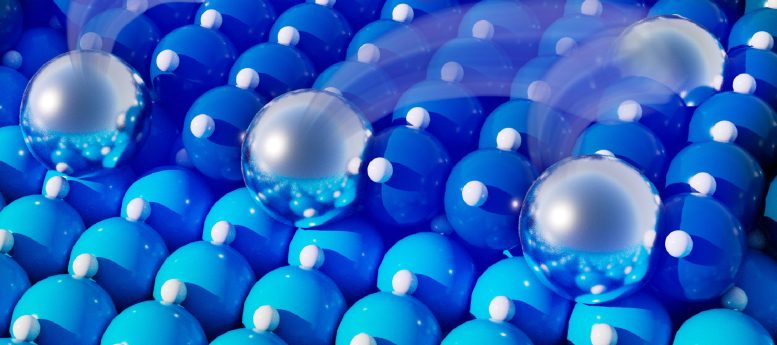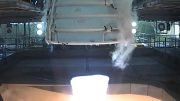
Researchers announced that individual palladium atoms attached to a catalyst can effectively remove 90% of unburned methane from natural-gas engine exhaust at low temperatures. This innovative single atom catalysis could potentially reduce emissions of methane, a significant greenhouse gas.
Researchers demonstrate a way to remove the potent greenhouse gas from the exhaust of engines that burn natural gas.
A new catalyst using single palladium atoms can efficiently remove 90% of unburned methane from natural-gas engine exhaust, potentially making a significant contribution to reducing greenhouse gas emissions. Further research is underway to advance the technology and move closer to commercialization.
Revolutionizing Methane Emission Control: A New Catalyst Approach
Individual palladium atoms attached to the surface of a catalyst can remove 90% of unburned methane from natural-gas engine exhaust at low temperatures, scientists reported on July 20 in the journal Nature Catalysis.
While more research needs to be done, they said, the advance in single-atom catalysis has the potential to lower exhaust emissions of methane, one of the worst greenhouse gases, which traps heat at about 25 times the rate of carbon dioxide.
Promising Results Across Engine Operation Temperatures
Researchers from the Department of Energy’s SLAC National Accelerator Laboratory and Washington State University showed that the catalyst removed methane from engine exhaust at both the lower temperatures where engines start up and the higher temperatures where they operate most efficiently, but where catalysts often break down.

Today’s catalysts for removing unburnt methane from natural gas engine exhaust are either inefficient at low, start-up temperatures or break down at higher operating temperatures. A new single-atom catalyst developed by SLAC National Accelerator Laboratory and Washington State University solves both these problems and removes 90% of the methane. This illustration depicts individual palladium atoms (white) removing methane (white bubbles) at the surface of the catalyst. Credit: Cortland Johnson/Pacific Northwest National Laboratory
“It’s almost a self-modulating process which miraculously overcomes the challenges that people have been fighting – low temperature inactivity and high temperature instability,” said Yong Wang, Regents Professor in WSU’s Gene and Linda Voiland School of Chemical Engineering and Bioengineering and one of four lead authors on the paper.
Addressing Methane Emissions From Natural Gas Engines
Engines that run on natural gas power 30 million to 40 million vehicles worldwide and are popular in Europe and Asia. The natural gas industry also uses them to run compressors that pump gas to people’s homes. They are generally considered cleaner than gasoline or diesel engines, creating less carbon and particulate pollution.
However, when natural-gas engines start up, they emit unburnt, heat-trapping methane because their catalytic converters don’t work well at low temperatures. Today’s catalysts for methane removal are either inefficient at lower exhaust temperatures or they severely degrade at higher temperatures.
The Catalyst’s Economic and Environmental Impact
“There’s a big drive towards using natural gas, but when you use it for combustion engines, there will always be unburnt natural gas from the exhaust, and you have to find a way to remove that. If not, you cause more severe global warming,” said co-author Frank Abild-Pedersen, a SLAC staff scientist and co-director of the lab’s SUNCAT Center for Interface Science and Catalysis, which is run jointly with Stanford University. “If you can remove 90% of the methane from the exhaust and keep the reaction stable, that’s tremendous.”
A catalyst with single atoms of the chemically active metal dispersed on a support also uses every atom of the expensive and precious metal, Wang added.
“If you can make them more reactive,” he said, “that’s the icing on the cake.”
The Role of Carbon Monoxide in Catalyst Efficiency
In their work, the researchers showed that their catalyst made from single palladium atoms on a cerium oxide support efficiently removed methane from engine exhaust, even when the engine was just starting.
They also found that trace amounts of carbon monoxide that are always present in engine exhaust played a key role in dynamically forming active sites for the reaction at room temperature. The carbon monoxide helped the single atoms of palladium migrate to form two- or three-atom clusters that efficiently break apart the methane molecules at low temperatures.
Then, as the exhaust temperatures rose, the clusters broke up into single atoms and redispersed, so that the catalyst was thermally stable. This reversible process enabled the catalyst to work effectively and used every palladium atom the entire time the engine was running – including when it started cold.
“We were really able to find a way to keep the supported palladium catalyst stable and highly active and, because of the diverse expertise across the team, to understand why this was occurring,” said SLAC staff scientist Christopher Tassone.
Future Directions
The researchers are working to further advance the catalyst technology. They would like to better understand why palladium behaves in one way while other precious metals such as platinum act differently.
The research has a way to go before it will be put inside a car, but the researchers are collaborating with industry partners as well as with DOE’s Pacific Northwest National Laboratory to move the work closer to commercialization.
Reference: “Dynamic and reversible transformations of subnanometre-sized palladium on ceria for efficient methane removal” by Dong Jiang, Gang Wan, Joakim Halldin Stenlid, Carlos E. García-Vargas, Jianghao Zhang, Chengjun Sun, Junrui Li, Frank Abild-Pedersen, Christopher J. Tassone and Yong Wang, 20 July 2023, Nature Catalysis.
DOI: 10.1038/s41929-023-00983-8
Along with Wang, Abild-Pedersen, and Tassone, Dong Jiang, senior research associate in WSU’s Voiland School, also led the work. The work was funded by the DOE Office of Science, and included research carried out at SLAC’s Stanford Synchrotron Radiation Lightsource (SSRL), Argonne National Laboratory’s Advanced Photon Source (APS) and the National Energy Research Scientific Computing Center (NERSC), which are all DOE Office of Science user facilities.









“… has the potential to lower exhaust emissions of methane, one of the worst greenhouse gases, which traps heat at about 25 times the rate of carbon dioxide.”
For those of you applauding this ‘breakthrough,’ you might want to read this:
https://wattsupwiththat.com/2023/03/06/the-misguided-crusade-to-reduce-anthropogenic-methane-emissions/
Methane is the primary contributor to the formation of ground-level ozone, a hazardous air pollutant, exposure to which causes 1 million premature deaths every year. So, even if it weren’t a greenhouse gas, reducing it’s levels where we are making it higher helps us reduce air pollution where we literally, “live and breath.”
I’ve always been suspicious that if one were to add ALL the claimed contributors to premature death, the result would be a number several times the extant population. Be that as it may, Wiki’ states that “Tropospheric Ozone causes approximately 22,000 premature deaths per year in 25 countries in the European Union.” Where are the other 978,000 occurring?
Tropospheric ozone, a major component of smog, is created by a photochemical reaction between nitrogen monoxide and Volatile Organic Compounds (VOC), of which methane is typically a minor constituent. In the Great Smoky Mountains, turpenes from the trees are the major source of VOCs. In urban areas, catalytic converters were mandated to reduce VOCs produced by combustion in internal combustion engines, which has helped reduce ozone and smog. With an average global concentration of less than 2PPM methane, I question whether methane is “THE primary contributor to the formation of ground-level ozone.” Perhaps you could provide citation to support your claim.
Having spent some of my youth living in the San Fernando Valley [north of Los Angeles] during a time when cars still vented crankcase fumes into the air, I’m well acquainted with smog, having seen it so thick that I could barely see the homes across the street from my school’s playground. So, I’m in favor of reducing human exposure to smog. However, I want to be sure that the time and money spent in the effort is most effective and isn’t wasted chasing the ‘Chimera of the Day.’ That means hard-nosed analysis of the problem with numbers attached to the measurements, and not just qualitative hand waving.
“The research has a way to go before it will be put inside a car”
Given that all future cars will be driven by electricity from batteries or H2, this appears to be dead-end research.
I wish I could be as certain about the future as you seem to be. ICE technology is very mature. There are many good reasons to continue to use it.
There are still a lot of problems with batteries, such as spontaneous combustion, that need to be worked out. Hydrogen has its own set of problems, not the least of which is embrittlement of containers and what is probably the widest range of explosiveness in the presence of oxygen of any gas. Something that is never mentioned is that instead of putting CO2 into the atmosphere, very likely hydrogen will increase the relative humidity of the cities where it is used, and contribute to accidents from wet/icy pavements if allowed to drip onto the roads. People will not want to have to empty a holding tank every few hours, which will create its own set of problems when scaled up to the whole population.